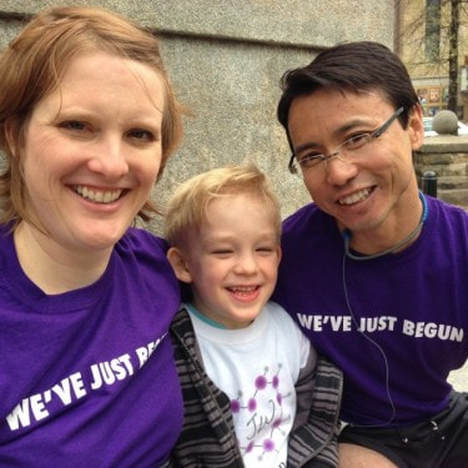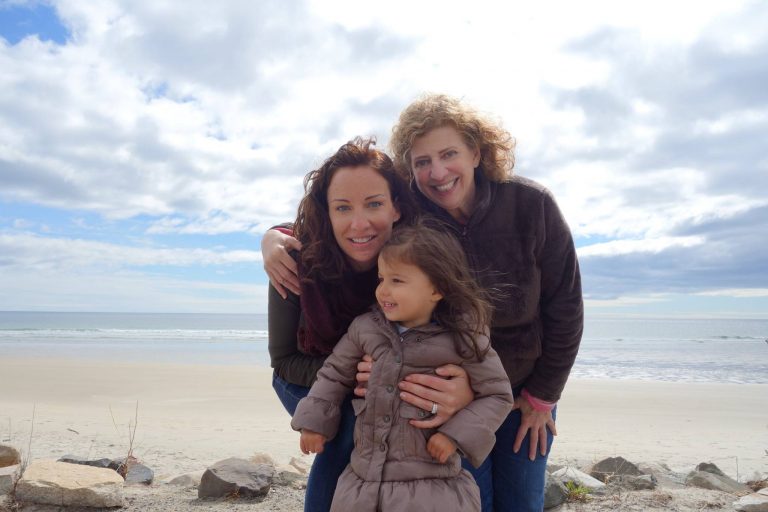|
SSP: How did Jonah’s Just Begun come to be?
Jonah was born July 30th, 2008, happy and healthy. Jeremy and I couldn’t take our eyes off of our remarkable son. At Jonah’s first-year well visit our astute pediatrician, Dr. Hai Cao, suggested we get Jonah an MRI. Dr. Cao noted that the size of Jonah’s head was “off the charts.” Nine months later, Jeremy and I received news that changed our lives a second time: Jonah had Sanfilippo Type C, a rare disease that is both fatal and incurable. Love doesn’t falter for your child after a horrific diagnosis. If anything it grows stronger. From that point forward, we understood that every second with our son was precious. We no longer take any family time spent together for granted. http://jonahsjustbegun.org/ Jonah is 8 now and finishing up 2nd grade at ps10. He still has no idea that he’s sick and we plan to keep it that way. SSP: What exactly is Sanfilippo and how are children affected? Sanfilippo Syndrome is caused by a defect in a single cell. It is an inherited disease of metabolism that means the body cannot properly break down long chains of sugar molecules called mucopolysaccharides or glycosaminoglycans (aka GAGs). Sanfilippo syndrome belongs to a group of diseases called mucopolysaccharidoses (MPS). Specifically, it is known as MPS III. Sanfilippo Syndrome occurs when the enzymes the body needs to break down the Heparan Sulfate (HS) are absent or are defective. When HS is not broken down, the body does not release it. Instead, it is stored inside the lysosomes of every cell in the body. To date there are four types of Sanfilippo syndrome. They are distinguished by the enzyme that is affected.
Between the four types of Sanfilippo, the syndrome present in approximately 1 in 70,000 births. SSP: What happens to a child with Sanfilippo Syndrome? Sanfilippo is an insidious disease that often goes undetected for years. Most children are born with no visible signs that anything is wrong. It’s not until the preschool years that children start to show cognitive delays or course facial features; even then, the disease is often misdiagnosed. Sanfilippo is progressive and can be broken down into stages. First stage: The affected child will display delayed speech as well as mild facial abnormalities and behavioral issues. Some children will exhibit a large head, prominent forehead, bushy eyebrows, coarse hair, thick skin, short neck, full lips, low thick ears, a wide flat nose and full round bellies. Their facial features are described as “coarse.” Affected children are prone to sinus and ear infections, diarrhea, and tight Achilles tendons. Minor bone deformities are quite common. Second stage: The affected child will become extremely active, restless, suffer sleeplessness and exhibit difficult or ‘quirky’ behavior. Over time, speech and communication skills decline along with other cognitive and motor skills. Third stage: The disease will take its ultimate toll. The child will lose the ability to walk, talk and eat on his own while his body shuts down. Depending on the phenotype of the disease, death can occur as early as three years or as late as 30 years old. Currently there is no cure for Sanfilippo Syndrome. In most cases, treatment is limited to reducing or controlling the symptoms of this disorder by making sure that neurologists, ophthalmologists, cardiologists, ENTs, orthopediatricians, dentists and genetic counselors are consulted routinely. SSP: How rare (or ultra-rare) is this disease and is there a treatment? There currently is not a treatment for Sanfilippo Syndrome. We do not know the exact incident rate of Sanfilippo type C. A few papers suggest 1 in 1.5 million births. By that measure there should be 4 babies born a year with Sanfilippo C. We only know of 20 cases in the U.S. SSP: What is the current research? JJB along with our consortium: Helping Advance Neurodegenerative Disease Science (H.A.N.D.S.), made up of international medical research foundations, is struggling to keep the research funded. Our main research program is gene therapy, taking place in Manchester, UK. Since 2012, H.A.N.D.S. has collectively funded over $800,000 into this program. We are nearing clinical trial. We have one more pivotal study to complete before we can go to the Food and Drug Administration with our clinical trial protocol. Over the next two years H.A.N.D.S. plans to raise $500,000 to complete this study. SSP: What is next/what can you share with us? It has been a very exciting and progressive year for us. Our Natural History Study has finally been given approval by the National Institute of Health! If all goes as planned Jonah will be the first child to be enrolled in this study. Jonah and children like him will spend two days at Montiforie Childrens Hospital undergoing a battery of tests. From clinical tests to cognitive and behavioral exams, this data will help us gain a better understanding of the course of the disease. The patient registry that JJB manages for all Sanfilippo subtypes has gained global exposure and the attention of pharmaceutical companies. This has helped us identify our global patient population, giving us a much better idea of incident rate and phenotype. After clinical trial we will need investors to manufacture and commercialize our treatment. To help facilitate this partnership, we founded a virtual biotech, Phoenix Nest. The biotech puts us in a better position of attracting investors. http://www.phoenixnestbiotech.com/ The biotech also gives us the opportunity to apply for funding from the National Institute of Health. We have been very successful in winning these grants. The rub, these grants are for type B and D Jonah has type C. The NIH funding stipulates that the science happens in the United States. Our scientists working on type C live and work abroad. To get around this Phoenix Nest is in the process of licensing our gene therapy so that it belongs to a US based company. http://www.raredr.com/news/phoenix-nest-grant SSP: What is needed NOW and how can we help support you? We continue to raise funds to keep our research from slowing. With our ‘Heroes Among Us’ event on July 23rd we hope to raise the amount of $17,598.00 to pay for the production of our enzyme for our Sanfilippo type C gene therapy program. For information on the event, please go to: Event Info To make a donation, please go to: Donations For more information on Jonah’s Just Begun organization, please go to: http://jonahsjustbegun.org/
0 Comments
Leave a Reply. |
Jen Valu
|



 RSS Feed
RSS Feed




